
Trailblazers: Healing and Hope Among Us
This article was first published by the Duke Cancer Institute.
On July 15, 2009, Duke Law School alum and father-of-three Jeff Bradford, then 31, was on his way home from taking an expert witness deposition in Greensboro, North Carolina, when his car was hit by a drunk driver.
In lieu of suing the driver in the aftermath of the accident — his first impulse —the attorney would instead be inspired to form a band and write a song crediting the driver with unknowingly saving his life.
That same summer Tom O’Donnell, then 45, was busy managing a Kerr Drugs in Pittsboro, NC, and looking forward to kicking back on a cruise with his wife and daughter. Tom, who hadn’t run in two decades, would never have believed that completing the Boston Marathon several times over would figure in his vacation plans in the coming years.
In the summer of 2009, Nestor Paonessa, 29, was planning, with his fiancée, a winter beach wedding in Puerto Rico, the birthplace of Nestor’s parents.
If the assistant general manager and personal trainer at Empower Personalized Fitness in Durham had a crystal ball he would have seen that after five years of marriage he and his wife would be hiking the Inca Trail to Machu Picchu (on their bucket list) and building their dream home. What he’d never have imagined was the next uphill climb he'd make.
While all three men were local, Jeff, Tom and Nestor may never have met had it not been for one thing in particular they had in common — something that would radically change the trajectory of each of their lives and land them on the same path, one foot in front of the other. They each had a brain tumor.
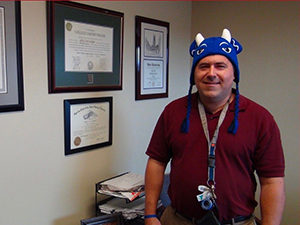
Jeff's Story: "A Close Call"
The inebriated grandma, Gerline, had come out of nowhere. She’d blown through the turn lane and come straight towards him. With no time to react, he’d hit the brakes and slammed into her. His airbag had deployed as he and Gerline careened across several lanes of traffic, landing them both directly in front of Bojangles — where she’d originally been headed.
Both drivers came out of the “extremely frightening” accident relatively unscathed, physically.
However, as Jeff later told colleagues, “What followed was probably the scariest night of my life, spent trying to grasp the potential of a world where my three young daughters would grow up and go to high school and college and get married, etc., and I wouldn’t be there to see it.”
The next morning, he woke up with a localized headache on the left side of his head. Thinking it was a concussion, a friend urged him to visit urgent care. But a head CT scan, soon followed by an MRI, picked up something else.
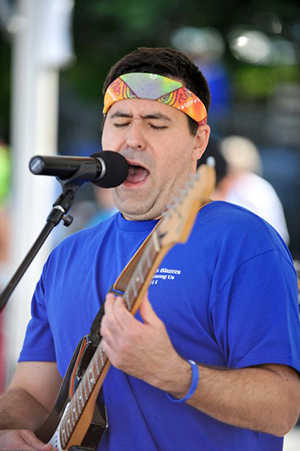
“An ER physician with a mediocre-at-best bedside manner informed my wife and me that I had a brain tumor in my frontal left lobe between the size of a golf ball and tennis ball,” said Jeff.
Jeff, along with his wife Andi, also a Duke Law alum, asked around at Duke for a neurosurgeon referral and found Allan Friedman, MD, who, Jeff said, “had the aura of a healer… a neurosurgeon to the stars.”
Following surgery to remove the entire mass, what Jeff described as “a sizable chunk” of the emotional center of his brain, he was diagnosed with a grade-2 oligodendroglioma, a low-grade finger-like tumor. His was caught early enough to be benign. If this type of tumor were to become a fast-growing grade-3, it would be considered cancerous.
Jeff ruled his accident a “a miracle,” with Gerline, the woman who struck his car, an unlikely hero. If not for the accident, he may not have discovered he had a brain tumor until it was too late. These kinds of tumors are notorious for forming and growing slowly years before any symptoms are felt; in this way, evading detection.
For the past 10 years, Jeff has performed a rollicking story-song he wrote about his tumor experience. The over-nine-minute song, as funny a song as it can be considering the subject matter, begins at the scene of the accident.
The catchy refrain, repeated a few times throughout goes: “Gerline, thank you for a case of the munchies, and thank you for the voices in your head, that told you to go to Bojangles and use a coupon and buy some chicken. If not for you, well, I might just be dead.”
The song ends with the reveal that, for Gerline, the accident was also life-changing. She gets the mental health help she needs and they both learn how “The Lord moves in mysterious ways.” [Listen to “Gerline” as sung and performed by Jeff, on guitar]
Eleven years since diagnosis and roughly 40 clear MRI’s later, Jeff’s brain shows no evidence of disease. He’s had his “ups and downs” dealing with the mental deficits that can result from brain surgery, but he’s feeling good and is happy to be enjoying time with his family. Like many parents during the pandemic, he’s been busy the last few months helping his three daughters get through online schooling.
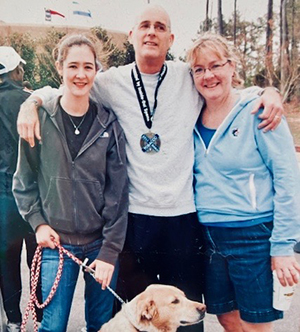
his first qualifying run for the Boston
Marathon — his wife Mary, his daughter
Kerry, and the family dog Spencer. (2011)
Tom's story: Marathon Man
After complaining of eye twitching for nearly a year, Tom O’Donnell’s doctor finally ordered an MRI in June 2009. He remembers the day he stepped out for the scan on his lunch break.
On July 8, 2009, neurosurgeon Allan Friedman, MD, removed 60 percent of what turned out to be a grade 2 oligodendroglioma, the same one Jeff was battling.
Tom, then 45, came out of surgery with his mobility mostly intact. He decided then, to start running again, which he hadn’t done since high school. Eight months later he ran his first marathon — the Tobacco Road Marathon. His oncologist Katherine Peters, MD, PhD, was at the finish line to see him cross it.
Then, in spring 2012, he ran his first Boston Marathon. It was the hottest one in race history. When he first learned he qualified, he showed up in his surgeon’s clinic to let him know in person.
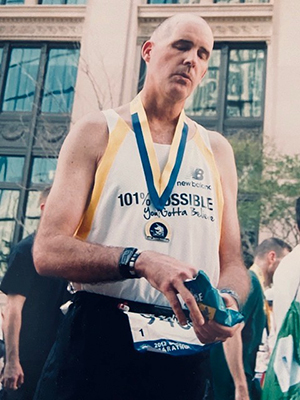
2012. He’ll run his eighth Boston Marathon,
postponed due to COVID-19, as a virtual
race in September.
“Dr. Friedman told me he was jealous, I let him know I could not have done it without him,” said Tom.
Then, in 2013, a setback. A biopsy revealed his tumor had progressed to a fast-growing grade 3 cancerous tumor. He’d undergo a second surgery; this time followed by a year of chemotherapy. His third and latest brain surgery was on June 29, 2017. He came out of it with flying colors.
Tom is today a 10-year survivor who wears his heart on his sleeve (and it’s often the sleeve of a Survivor t-shirt).
He chokes up when he talks about what it means to be alive. To see his daughter Kerry graduate from high school and college and start veterinary school. To spend time with his wife of 25 years, Mary. To live to run another day “just because I can.” He’s run seven Boston Marathons and 29 regular marathons so far.
“After my first surgery, Dr. Friedman told me to go and live the rest of my life,” O’Donnell remembers. “That was enough for me – and it still is.”
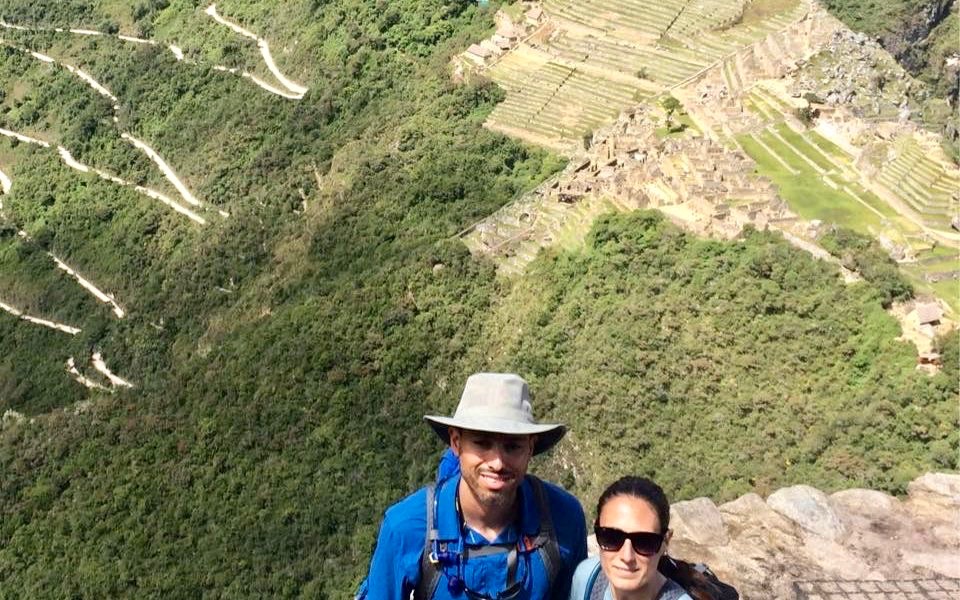
Nestor's Story: To the Summit and Back
Nestor Paonessa, an avid tennis player and hiker raised on the island of St. Croix, started running marathons in 2010 and had completed two ultras in the Tough as Trails series prior to his bucket-list Machu Picchu trek.
“I was definitely on a high entering the summer of 2015,” said the UNC alum (Chapel Hill and Greensboro) with an advanced degree in sports and exercise science. “I was in the best shape of my life.”
The high was short-lived. Upon his return from Peru, he started getting double and rotated vision along with crushing headaches. Altitude sickness and physical exhaustion from the trip were ruled out. A Duke eye specialist eventually found a golf-ball sized mass sitting right on his brainstem and pushing up on the nerves of his eye. He was at risk of being paralyzed on the left side if the tumor was removed.
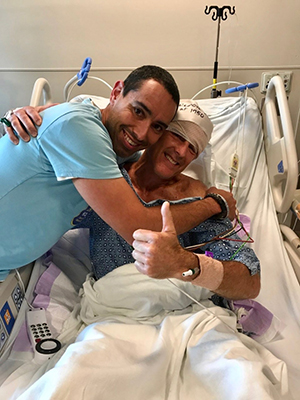
Paonessa after his latest brain surgery in
June 2017.
On Wednesday, July 1, 2015, less than a week after he’d met with neuro-oncologist Henry Friedman, MD, and neurosurgeon Allan Friedman, MD, Nestor was undergoing a craniotomy to remove most of the tumor. It was a grade 4 glioblastoma, one of the most aggressive, fastest-growing, and deadliest forms of brain cancer.
He recalled that for several weeks after surgery he felt “lost and disoriented in space and time.” He was far from seeing the light at the end of the tunnel.
“I had no idea what tunnel I was in, how long the tunnel was, or what direction the tunnel was facing,” he recalled.
Nestor was considered a fall risk due to a loss of strength and dexterity in his left arm and leg. He depended on the railing to go up and down stairs and leaned on his wife Ashley to walk up and down the street. He underwent intense brain radiation and chemotherapy, occupational therapy, physical therapy, and psychotherapy. He participated in a personalized clinical trial of a dendritic cell vaccine, an immunotherapy being developed at Duke, and he received two continuous years of chemotherapy.
Over that time, he developed patchy hair loss, an altered sense of taste, severe fatigue, and impaired short-term memory. A vision problem prevented him from driving for the first few months after surgery.
But he did the grueling work of rebuilding both his physical strength and his eye-hand coordination; returning to work within a few months of surgery, first part-time then full-time. He completed the Umstead 100-mile Endurance Run and summitted Mount Kilimanjaro in Tanzania — both before completing treatment in August 2017.
In January 2019, having had the foresight to bank sperm before he started treatment, and finally, success with IVF, Nestor and Ashley became the proud parents of Kai Amani. Their dream home was now complete.
“We’ve been fortunate that we’ve been continually moving forward and making our dreams a reality despite all this crap that happened,” Nestor reflected. “I’ve been able to cross a couple bucket list items off my list. The biggest one, the one that’s given me the most joy is Kai Amani, my son.”
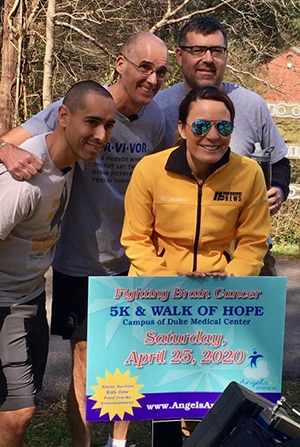
reporter Amber Rupinta, during a photo
shoot for a TV feature on their inspiring story.
(Before the pandemic canceled or postponed
all road races) (photo by Katie Massey)
Brain Brothers
Jeff, 42, Tom, 55, and Nestor, 39, have gotten to know each other over the years through the annual Angels Among Us 5K & Walk of Hope fundraising event hosted by the Preston Robert Tisch Brain Tumor Center at Duke.
This winter, the self-described “brain brothers” made plans to train and run their first marathon together. They chose Fort Bragg’s All-American Marathon.
Tom and Nestor had run together before. In the close-knit brain tumor family, they’re practically celebrities.
Jeff is familiar to many in the community for both his story song and his yearly guitar performance of "Angels Among Us" with Nestor on keyboards and another survivor, Alan Stephenson, on vocals.
Jeff was a marathoner before diagnosis, but had fallen out of shape in the years following treatment. His friends Tom and Nestor gave Jeff the push he needed to get back on track.
In a couple radio appearances this February, the brain brothers talked up their plans for both the March 29th All-American Marathon and April 25th Angels Among Us event.
In early March, they were joined on the American Tobacco Trail by local ABC-11 TV reporter Amber Rupinta who told the brain brothers’ inspiring story.
When the All-American Marathon was subsequently canceled due to concerns over coronavirus, they committed to run the Tobacco Road Marathon course together instead. But that plan was thwarted by revised social distancing laws.
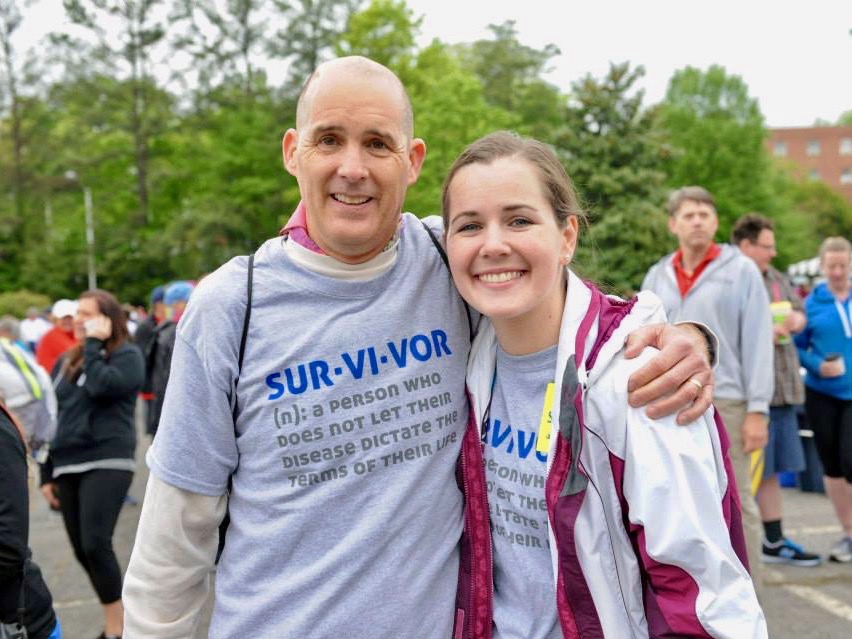
Hope.“I recall her telling me how the following year she would run the 5k and she did,” he said.“She was grinning from ear to ear
when she told me that she ran the entire 5k. She was so proud.”
One for All & All For One
Then, a devastating blow they didn’t see coming. The brain brothers learned that one of their biggest heroes and beloved “brain family” members, Stephanie (Lipscomb) Hopper had just passed away. She was their hope and inspiration.
In 2012, Stephanie had become the world’s first person to be treated with an injection of a modified poliovirus directly into her brain tumor. Her participation in the Preston Robert Tisch Brain Tumor Center research trial gave her eight more years of life, which she lived to the fullest.
They chose to memorialize her the best way they knew how. They’d run a marathon especially for her, and in doing so give hope to others.
On Sunday, March 29th, three days after her death, they each ran one-third of a marathon— together, totaling a little over the 26.2 miles that make up a single marathon. Learning about their plan through social media, a few other runners also got on board with #9milesforStephanie.

#9MilesForStephanie. “Undoubtedly she was
destined for even greater things in her life
that was cut all too short, but her amazing
legacy that she leaves behind and the hope
that she instilled in the rest of us survivors
are and will always be the greatest things of
all,” said Nestor.
“Stephanie was without a doubt the bravest person I have ever and will ever meet,” said Tom.
One time, he recalled, she invited him to visit her during a booster injection of the modified poliovirus.
“I went to visit her and was a bit early. I offered to leave the room when the team came in to begin the process,” he shared. “Stephanie informed me that I did not have to. It was then, first-hand, that I saw what brave looks like — a tube sticking out of the top of her skull with an injection that contained the modified poliovirus. I believe Stephanie was still in nursing school at the time and had graduation and her wedding coming shortly. She was so full of both life and hope. I will always have this memory.”
Tom’s a survivor’s survivor; someone doctors often call on to help a newly diagnosed brain cancer patient cope with the news. He embraces hope and shares it with others.
This spring, his oncologist reached out to see if he’d be open to speaking briefly with a patient of hers, another marathoner who’s been newly diagnosed with what could be glioblastoma. Tom and the patient were on the phone for an hour.
“We made plans to run as soon as both us were up to it,” said Tom, who may get elective surgery to strengthen his ankle. “Needless to say, with what we had in common we struck it right off. Before the conversation ended he thanked me for taking the time to speak with him and said that I had inspired him and gave him hope… To be able to share my experience and be able to do this for a fellow patient, there are no words.”
Nestor described losing six friends to brain cancer already in the five years since he was diagnosed, including his friend Greg Sousa, a cyclist and iron man triathlete. Greg, Nestor and Ashley served together on the Angels Among Us planning committee.
“Greg was the original bad ass athlete with brain cancer,” said Nestor. “There’s a certain amount of survivor guilt; like why did he have to go and I’m still here?”

Bradford's Blazers — did a virtual run
together when Angels Among Us was
postponed this year.
Despite the losses, Nestor continues to make these connections. Like Tom, he’s been public with his cancer story because he feels he’s helping people.
“I’m happy to be a part of whatever spreads the message of hope,” he said.
Jeff, inspired by his friends, is now, himself, leading by example.
“I owe it to Duke and to all people with brain tumors to show them what I can do as a survivor,” Jeff told ABC-11 reporter Amber Rupinta while training on the Tobacco Trail in March. "Nobody is guaranteed tomorrow, so you might as well live today to the fullest. Because you never know."
You never know what’s around the next corner. But if you have a brain tumor, you can bet these three brain brothers will be there to meet you there if you need them.
Julie Harbin is a senior writer with the Duke Cancer Institute.
